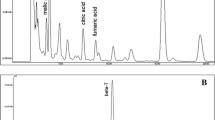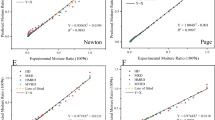Abstract
To select a suitable drying process for using chestnut products in the food industry, this study investigated the effect of five drying methods, including natural drying, microwave drying (MD), hot air drying (HAD), freeze-vacuum drying (FVD) and microwave-vacuum drying (MVD) on the nutritional composition, flavor, and functional properties of dried chestnuts. The results indicated that the nutritional aspects and functional properties of chestnuts were enhanced by the freeze-drying process compared with the other four drying methods. The quality of the chestnuts dried using the MVD was second to the FVD. The hot-air dried products were quite similar to the naturally dried samples in terms of their functional component content and processability. In terms of the produce texture, the HAD was found to be the best. In total, 45 flavor components were identified in the samples, which comprised the following: 5 aldehydes, 4 alcohols, 4 esters, 8 terpenes, 16 hydrocarbons and, 8 others substances. The highest relative content of the ingredients in microwave-vacuum dried samples was pyrazine and 3-ethyl-2, 5-dimethyl. In the samples treated using the other four drying methods, benzyl alcohol was the ingredient with the highest concentration. Considering the fast drying rate, low energy consumption, and improved quality of chestnut products, MVD is the most suitable dehydration method for commercial production of Chinese chestnuts.

Similar content being viewed by others
References
AOAC (2000) Official methods of analysis, 16th edn. Association of Official Analytical Chemists, Washington
Barakat A, DiLoreto DS, Zhang Y, Smith C, Baier K, Powell WA, Wheeler N, Sederoff R, Carlson JE (2009) Comparison of the transcriptomes of American chestnut (Castanea dentata) and Chinese chestnut (Castanea mollissima) in response to the chestnut blight infection. BMC Plant Biol 9(1):51
Borges O, Gonçalves B, Carvalho JLSD, Correia P, Silva AP (2008) Nutritional quality of chestnut (Castanea sativa, Mill.) cultivars from Portugal. Food Chem 106(3):976–984
Doymaz Dİ (2010) Effect of citric acid and blanching pretreatments on drying and rehydration of Amasya red apples. Food Bioprod Process 88(2–3):124–132
Dutta B, Raghavan GSV, Dev SRS, Liplap P, Murugesan R, Anekella K, Kaushal T (2012) A comparative study on the effects of microwave and high electric field pretreatments on drying kinetics and quality of mushrooms. Dry Technol 30(8):891–897
Feng AG, Li GX, Li CY (2012) Research progress of food drying technology. Farm Mach 18:90–93
Guo DS, Peng XL (2007) Comparative study on antrone chromametry and enzymatic hydrolysisfor assay starch method. J Hunan Univ (Nat Sci Edit) 19(3):34–36
Huang LP (2012) Storage of chestnut at the normal temperature difficulties and countermeasures. Shanxi For Sci Technol 4:120–122
Kaymak-Ertekin F (2002) Drying and rehydrating kinetics of green and red peppers. J Food Sci 67(1):168–175
Krist S, Unterweger H, Bandion F, Buchbauer G (2004) Volatile compound analysis of SPME headspace and extract samples from roasted Italian chestnuts (Castanes mollissima) using GC-MS. Eur Food Res Technol 219(5):470–473
Li H, Yuan F, Lin HT, Lin YF, Chen YH, Wang SQ (2011) Research advances of microwave vacuum drying technology for dried food processing. Packag Food Mach 29(1):46–50
Lin SS, Zhu MY, Zhang JW (2010) Research status and prospects of Chinese chestnut. Acad Aeriodical Farm Prod Process 12:74–76
Mamat H, Abu Hardan MO, Hill SE (2010) Physicochemical properties of commercial semi-sweet biscuit. Food Chem 121(4):1029–1038
Morini G, Maga JA (1995) Volatile compounds in roasted and boiled Chinese chestnut (Castanes mollissima). Lebensm Wiss u Technol 28:638–640
Qi XJ, Gou JX, Han XJ, Yan B (2004) Study on measuring reducing sugar by DNS reagent. J Cellul Sci Technol 12(3):17–19
Ratti C (2001) Hot air and freeze-drying of high-value foods: a review. J Food Eng 49(4):311–319
Rodríguez-Burruezo A, Kollmannsberger H, González-Mas MC, Nitz S, Nuez F (2010) HS-SPME comparative analysis of genotypic diversity in volatile fraction and aroma contributing compounds of Capsicum fruits from the annuum–chinense–frutescens complex. J Agric Food Chem 58(7):4388–4400
Thang NT, Do TV, Sato T, Binh NT, Kozan O, Cam NV (2016) Yield and nutrient content of chestnut (Castanopsis piriformis) in catural central highlands forests, Vietnam. Small Scale For 15(2):229–239
Wang HC, Zhang M, Adhikari B (2014) Drying of shiitake mushroom by combining freeze-drying and mid-infrared radiation. Food Bioprod Process 94:507–517
Xu TC, Wang WL, Liu J (2011) Development trends and progress of chestnut products in China. Food Nutr China 17(8):17–19
Yang L, Xiao L, Wang Q (2014) Study on texture properties of apple flesh by using texture profile analysis. J Fruit Sci 31(5):977–985
Zheng CX (2001) Chestnuts drying character and chestnut dryer. J Chin Cereals Oils Assoc 16(5):55–58
Zhou J, Kong XL, Gao N (2009) Effects of combination of microwave and hot-air drying on characteristics of chestnuts. Packag Food Mach 2:11–13
Acknowledgements
Financial support from the Key Scientific and Technological Project of Henan province (No. 152102210386) and the Outstanding Youth Fund of Henan Province (No. 184100510010) is gratefully acknowledged.
Author information
Authors and Affiliations
Corresponding author
Rights and permissions
About this article
Cite this article
Zhang, L., Wang, Z., Shi, G. et al. Effects of drying methods on the nutritional aspects, flavor, and processing properties of Chinese chestnuts. J Food Sci Technol 55, 3391–3398 (2018). https://doi.org/10.1007/s13197-018-3227-6
Revised:
Accepted:
Published:
Issue Date:
DOI: https://doi.org/10.1007/s13197-018-3227-6




